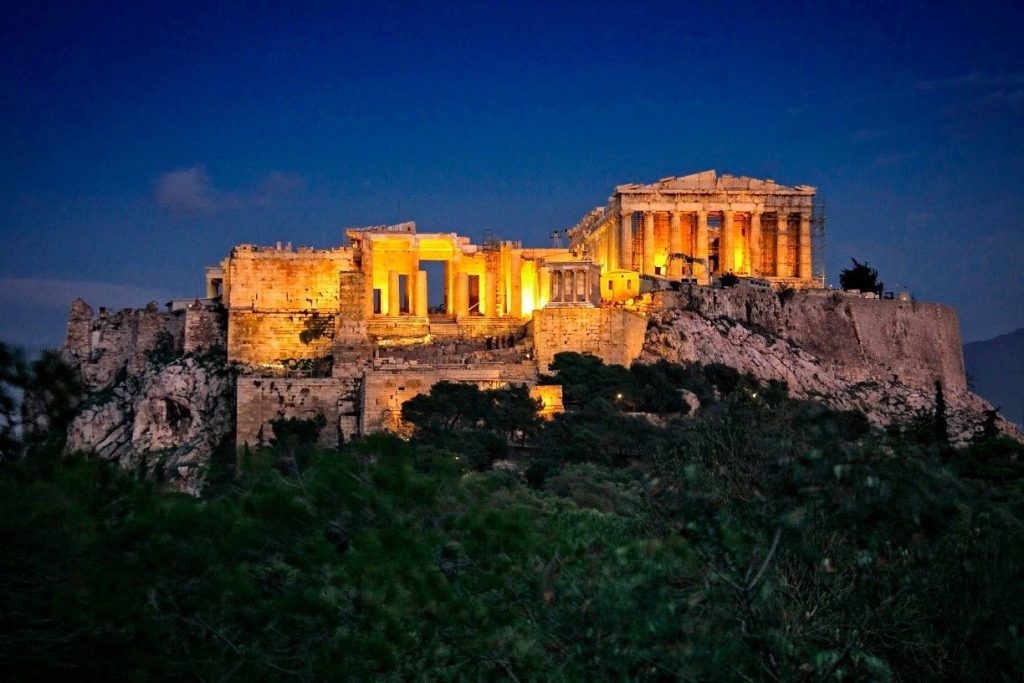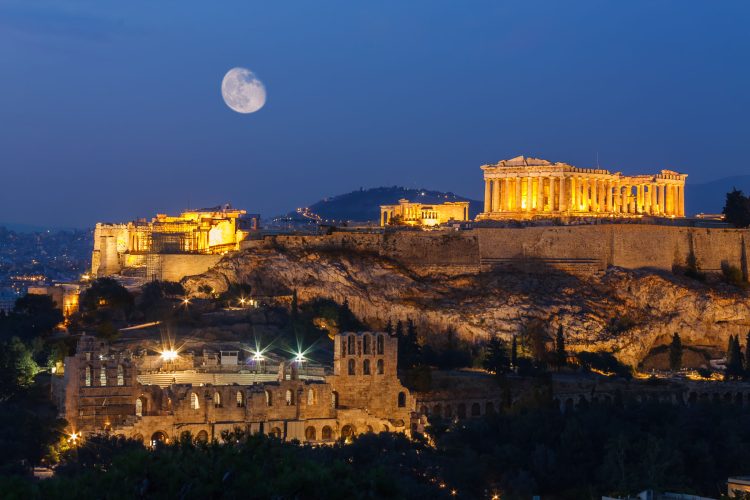Background, history and development
Acropolis, Ancient Greek for “high city” or “holy place”, is a sacred place dedicated to the patron saint of an ancient Greek city-state, often built on the steepest hill in the center of the city. Among them, the Acropolis is the most famous ancient Greek complex, located on a steep hill in the center of today’s Greek capital Athens, is the religious and political center. The Acropolis covers an area of about 4 square kilometers and is located on the Acropolis hill in the center of Athens. It was built in 580 BC. The earliest buildings on the Acropolis were the Athenaeum and other religious structures. The Acropolis of Athens, also known as the Acropolis of Athens, is Greek for “Acropolis”, meaning “city on a high hill”.
Ancient Greek cities had dual functions of wartime acropolis and peacetime civic life center, and gradually developed into the core of urban architectural groups, and acropolis buildings also focused on comprehensive utilization. Not only the plane layout is rigorous, the space is handled skillfully, but also pay attention to the relationship between the building and the environment, and the style is unique. During the Hellenistic period, many acropolis were built around the country, some of which combined with the terrain and cleverly used natural rocks as walls. The general characteristics of the construction of the ancient Greek Acropolis are: make full use of the natural terrain, the layout is free, the height is scattered, and the main and secondary are clear, whether it is in it or looking up from the city, you can get a good viewing effect.

The Acropolis is the highest level of sacred Greek architecture, temples, columns and carvings. The Acropolis is located on a low hill in the center of Athens, surrounded by mountains on three sides, and facing south towards the city of Athens, it is built on a natural steep slope 150 meters high. The earliest buildings on the Acropolis were the Athenaeum and other religious structures. Acropolis, originally meant to be the holy land of slave rulers, built temples here in ancient times, and is also a stronghold of urban defense. Located at the highest point in the center of Athens, the Acropolis was originally built for defense and gradually developed into a religious, political and recreational center. The Acropolis covers an area of about 4 square kilometers, about 280 meters long from east to west, and about 130 meters wide from north to south. The earliest buildings on the Acropolis were the Athenaeum and other religious structures. The Acropolis is the most outstanding ancient architectural complex in Greece, a comprehensive public building and the center of religion and politics. The main existing buildings are the Acropolis Gate, the Temple of Athena, the Temple of Erechtheon, the Temple of Iktheon, and the Temple of Victory.
The Acropolis is the most outstanding ancient architectural complex in Greece. It is a comprehensive public building and the center of religion and politics. The Acropolis covers an area of about 4 square kilometers and is located on the Acropolis hill in the center of Athens. It was built in 580 BC. The earliest buildings on the Acropolis were the Athenaeum and other religious structures. The Acropolis of Athens, also known as the Acropolis of Athens, is Greek for “Acropolis”, meaning “city on a high hill”. At the center of the Acropolis is the temple of Athena, the main building of the Acropolis, which is located on the highest point of the Acropolis. The temple is decorated with ivory and gold, and its roof is made of marble and decorated with gold leaf. It contains a statue of Athena, which is carved from gold and ivory, and the eyes are set with precious stones.
From 447 BC to 432 BC, the Athenians built the world-famous Acropolis complex here, which is the essence of Greek architecture. All the buildings of the Acropolis are built on the surrounding hillsides. The Acropolis complex has a free layout, high and low, and clear priorities. Whether inside or looking up from the city, you can see its perfect layout. In the center of the Acropolis is the temple of Athena, and around the temple is the essence of the Acropolis architecture. To the right of the temple is the Temple of Erehsius, the oldest surviving building on the Acropolis, dedicated to Athena and Poseidon. Legend has it that this is the place where Athena and Poseidon, the god of the sea, fought wits over being the protector of Athens.
Athena defeated Poseidon’s steed with an olive branch and became the protector of Athens. The temple has gone through many vicissitudes, and what remains of it has become a symbol of ancient Greek civilization. The six marble columns in front of the temple were later built in the Roman period. To the left of the temple is the Parthenon, the main building of the Acropolis. Built between 447 and 432 BC, it is a masterpiece of Greek architecture and art in its heyday. It faces east, is 69.54 meters long and 30.89 meters wide, and is surrounded by 46 marble columns. The column style of the temple is simple and strong and perfect, and the whole building gives people a solemn and strong feeling. The perfection of its column style and architectural structure makes it a representative of the history of ancient Greek architecture and influences the architectural art style of Europe for more than two thousand years.

Main functions and features
The main function of the Acropolis was to serve as a center of religious worship, of which the Temple of Athena was the center of the Acropolis and was dedicated to Athena, the patron saint of Athens. The Acropolis complex layout is free, high and low, and the main and secondary are clear, fully demonstrating the unique style of ancient Greek architecture. These buildings not only serve religious functions, but also serve as places for citizens to carry out social and political activities.
In terms of architectural style, the Acropolis adopts typical ancient Greek column architecture, including the Dorian and Ionian style. Doric architecture is solemn and vigorous, symbolized by men; On the other hand, Ionian architecture is elegant and beautiful, symbolized by women. These columnar buildings are not only structurally stable, but also aesthetically of a very high level.
In the functional layout, the Acropolis pays attention to the sense of hierarchy and three-dimensional space. Each part of the building group is connected by steps, corridors, etc., forming an organic whole. At the same time, the Acropolis also makes full use of the terrain, so that the buildings are integrated with the natural environment, reaching the realm of heaven and man.
In the use of materials, the Acropolis mainly used stone, especially marble. These stones have been carefully processed, not only hard texture, but also smooth and delicate surface, adding a simple and elegant atmosphere to the complex.
Cultural, social and economic contribution and impact
As an outstanding representative of ancient Greek architecture, the Acropolis of Athens has had a profound influence on later generations. In terms of culture, the Acropolis complex shows the unique charm of ancient Greek culture and provides valuable materials for the study of ancient Greek culture. In terms of society, the Acropolis complex was not only a place of religious sacrifice, but also a center for citizens to carry out social and political activities, which played a positive role in promoting the stability and development of ancient Greek society. In terms of economy, the Acropolis of Athens has attracted a large number of tourists to visit, which has brought huge economic benefits to the development of local tourism.
The Acropolis also provided a wealth of inspiration and reference for later generations in architectural art and sculpture art. Many ancient and modern architects and artists have drawn nourishment from it and created many excellent works. It can be said that the Acropolis of Athens is the precious heritage of the ancient Greek civilization, which has a profound impact on the development of human culture.
Comparison of advantages and disadvantages
As the representative of ancient Greek architecture, the Acropolis of Athens has many advantages. First of all, it is unique in architectural style, showing the unique charm of ancient Greek architecture. Secondly, the combination of practicality and aesthetics is fully considered in the functional layout of the Acropolis building group, which makes the building group both practical and ornamental. In addition, the Acropolis also makes full use of the terrain and environmental conditions, so that the buildings are integrated with the natural environment, reaching the realm of heaven and man.
The Acropolis also has some shortcomings. Due to the vicissitudes of life, many of the buildings in the Acropolis complex have suffered serious damage, and some even no longer exist. This makes it impossible for later generations to fully appreciate the original style of ancient Greek architecture. In addition, because the Acropolis complex is located on the hillside, the terrain is relatively steep, which also brings some inconvenience for tourists to visit and tour.
Compared with other similar projects, the Acropolis has significant advantages in architectural art, historical value and cultural connotation. For example, compared with the Colosseum in Rome, the Acropolis of Athens paid more attention to the expression of religious and cultural connotations rather than purely entertainment functions. Compared with the pyramids in Egypt, the Acropolis pays more attention to the artistry of the architecture and the integration with the environment. Therefore, it can be said that the Acropolis is one of the most representative buildings in ancient Greek civilization, with irreplaceable historical status and cultural value.
As an outstanding representative of ancient Greek architecture, the Acropolis of Athens has its unique style and profound cultural connotation. It has an important position in architectural art, historical value and cultural influence, and has a profound impact on the later generations. Despite some shortcomings, the Acropolis is still a valuable heritage that deserves our in-depth study and appreciation.





















